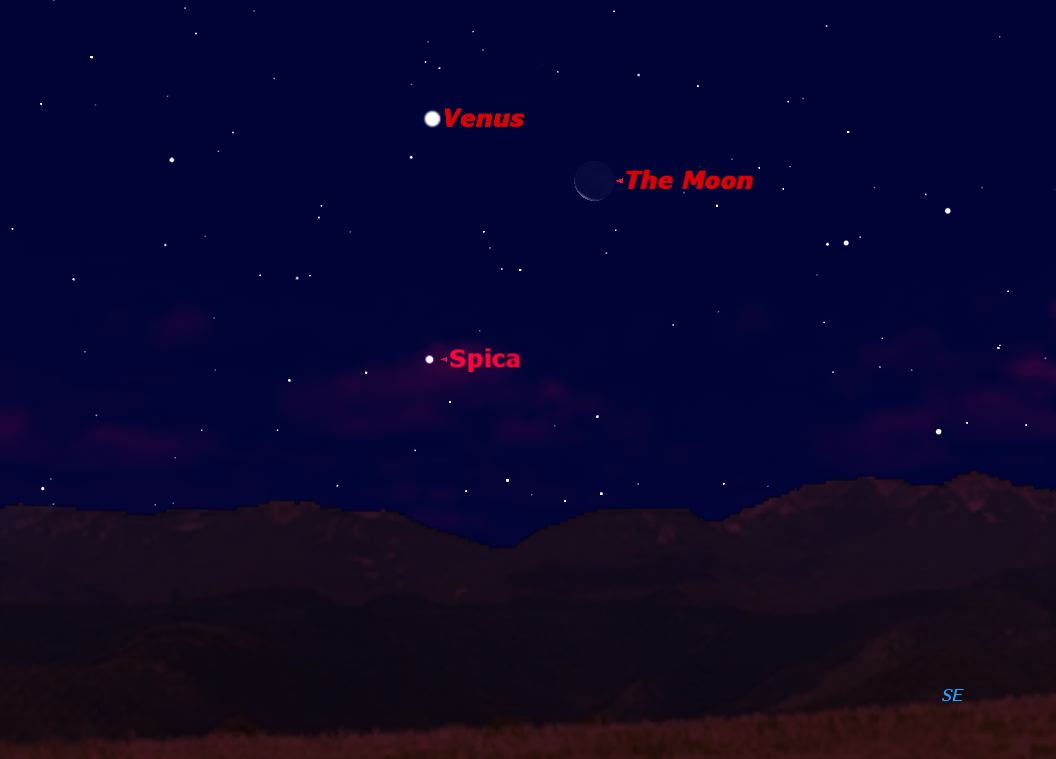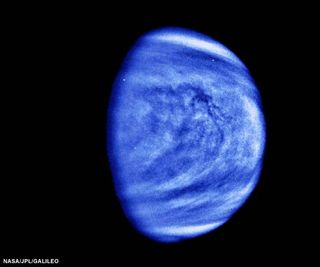
Early on Sunday morning (Nov. 11), early risers will be treated to a beautiful array of a brilliant planet, a bright star and a lovely slender crescent moon. The trio will form an eye-catching isosceles triangle in the dawn twilight.
The sky triangle will consist of Venus, the bluish star Spica in the constellation Virgo and a waning crescent moon, just 8-percent illuminated and only 2 1/2 days from new phase, as well as a total solar eclipse which will be visible over parts of Australia.
Shortly after 4 a.m. local time, Venus and the moon will emerge side-by-side above the horizon, a little to the south (right) of due east. Venus will be about 6 degrees to the left of the slender moon; your clenched fist, held at arm’s length, measures roughly 10 degrees, so Venus and the moon will be separated by about half a fist. About an hour later, Spica twinkles low through the glow of dawn, 9 degrees below both Venus and the moon.
Consider the isosceles triangle to be inverted; the base angles formed by Venus and the moon and the legs of the triangle extending downward toward Spica which marks the vertex angle.
Venus currently rises an hour before dawn, when its nearest rival, Jupiter stands high in the southwest. Make no mistake about it, Venus is brilliant as always. About 50 minutes before sunrise all through November, it blazes at least 20 degrees up in the south-southeast. But while Venus is by far the brightest planet once it gets clear of the horizon hazes, it is not nearly as showy as it was late last summer when higher and brighter. [Venus: 2nd Planet from the Sun (Video)]
Venus is now several months past greatest elongation and is retreating around the far side of the sun, so a telescope will show it gibbous and small.
After its brief moonlight tryst with our natural satellite on Sunday morning, naked eye observers will enjoy watching Venus go by Spica during the following week. On the mornings of Nov. 16 through Nov. 19 Venus is only 4 degrees from Spica, passing to its north. Of course, Venus will be far more brilliant than Spica, outshining that star by nearly 100-fold.
Get the Space.com Newsletter
Breaking space news, the latest updates on rocket launches, skywatching events and more!
And here too will be a fine finish to those who are conducting early morning vigils for the Leonid meteor shower, which will peak on Saturday, Nov. 17.
In the weeks to come, Venus will continue to get progressively lower in the morning sky. It will still be fairly prominent through the end of this year, but will rapidly fall into the sunrise light by the end of January or early February. So enjoy Venus now while it still blazes in our early morning sky.
Editor's note: If you and snap an amazing photo of Venus, Spica and the moon and would like to share it for a possible story or image gallery, send images, comments and location information to managing editor Tariq Malik at tmalik@space.com.
Joe Rao serves as an instructor and guest lecturer at New York's Hayden Planetarium. He writes about astronomy for The New York Times and other publications, and he is also an on-camera meteorologist for News 12 Westchester, New York.

Join our Space Forums to keep talking space on the latest missions, night sky and more! And if you have a news tip, correction or comment, let us know at: community@space.com.

Joe Rao is Space.com's skywatching columnist, as well as a veteran meteorologist and eclipse chaser who also serves as an instructor and guest lecturer at New York's Hayden Planetarium. He writes about astronomy for Natural History magazine, Sky & Telescope and other publications. Joe is an 8-time Emmy-nominated meteorologist who served the Putnam Valley region of New York for over 21 years. You can find him on Twitter and YouTube tracking lunar and solar eclipses, meteor showers and more. To find out Joe's latest project, visit him on Twitter.











